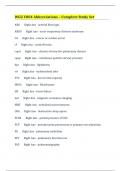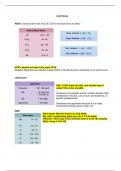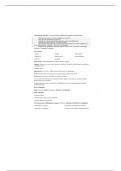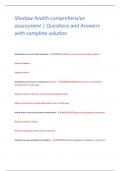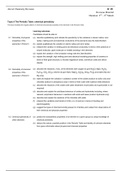NAME EXPLANATION VARIABLES FORMULAS BOO
K
Class widths The range divided by A guideline on choosing the number of Largest observation−Smalles Observation Ch 3.1
the number of classes. classes can be found in the book. Number of Classes P. 49
Sturges’s Calculates the n = number of observations 1+3.3 log ( n) Ch 3.1
Formula approximate number P. 50
of classes.
Mean The average μ= population meanN=number of observations N Ch 4.1
observation.
xi=observation i x=sample meann=sample ¿ ¿
∑ xi P. 99
i=1
μ=
xi=observation i N
n
∑ xi
i=1
x=
n
Median The observation that Ch 4.1
falls in the middle P. 100
when all the
observations are
placed in order.
Mode The observation that Ch 4.1
occurs with the P. 101
greatest frequency.
Variance Used to measure the σ 2= population variance μ= population mean
N Ch 4.2
variability of a set of ∑ ( xi−μ )2 P. 108
observations. N=number of observations xi=observation i 2
σ =
i=1
s =sample variance x=sample meann=sample ¿ ¿
2 N
xi=observation i
n
∑ ( xi−x )2
2 i=1
s=
n−1
Standard A measure of the σ = population standard deviation σ =√ σ 2 Ch 4.2
Deviation amount of variation or P. 112
s=sample standard deviation
dispersion of a set of
s= √ s
2
values.
Empirical Determines the 68% of all observations fall within 1 SD of Ch 4.2
Rule interval if the the mean P. 113
histogram is bell- 95% of all observations fall within 2 SD of
shaped. the mean
, 99.7% of all observations fall within 3 SD of
the mean
Chebysheff’s The proportion of k = the amount of standard deviations 1 Ch 4.2
Theorem observations in any k > 1, meaning k = 1 gives a proportion of 0
1− P. 114
k2
sample or population k = 2 gives 75% of all observations fall
that lie within k within 2 SD of the mean
standard deviations of k = 3 give 88.9% of all observations fall
the mean. within 3SD of the mean
Location of a The number resulting Lp=the location of the Pth percentile P Ch 4.3
Percentile from the formula tells
Lp=( n+1 ) P. 118
n=number of observations 100
you where in the order e.g. if Lp = 3.5, the location of the Pth
of a sequence of percentile is between the 3rd and 4th number
numbers, the in the ascending sequence.
percentile is located.
Probabilities The number of A ∪B=the∪of A∧B , A , B ,∨both occur Ch 6.2
probabilities must A ∩ B=both A∧B occur P( A ∩ B) P. 182
always sum up to C P ( A|B )=
A =the complement of A : A does not occur P( B)
exactly 1.
A∨B= A occurs given that B has occured
Bayes’s Law Situations where we P ( A ) × P(B∨ A) Ch 6.4
witness a particular P ( A|B )= P. 199
P ( A ) × ( PB| A ) + P( AC )× P(B∨ AC )
event and we need to
compute the
probability of one of
its possible causes.
Weighted The weighted average E ( X ) =expected valueμ= population mean E ( X ) =μ=∑ xP ( x ) Ch 7.1
Mean: of all its values all x P. 219
Expected (population mean). P ( x )=the probability of xx=observations
E ( c )=cE ( X + c ) =E ( X ) +c E ( cX )=cE ( X )
Value The weights are the Laws of Expected Value:
probabilities.
Weighted The variance adjusted V ( X )=σ =∑ ( x−μ ) P ( x ) Ch 7.1
2 2
V ( X )=varianceσ 2= population variance
Variance to the weighted all x P. 219
average. μ= population mea n P ( x )= probability of x
x=observations Laws of Variance: V ( c )=0V ( X +c )=V ( X )V ( cX ) =c 2 V ( X)
Binomial The probability of a P ( x )= probabilityx=number of successes n! x n−x Ch 7.4
Probability number of successes
P ( x )= p (1−p ) P. 241
n=number of trials p= probability of success x ! ( n−x ) !
Distribution in a binomial
experiment with a
number of trials and a
probability of success.
K
Class widths The range divided by A guideline on choosing the number of Largest observation−Smalles Observation Ch 3.1
the number of classes. classes can be found in the book. Number of Classes P. 49
Sturges’s Calculates the n = number of observations 1+3.3 log ( n) Ch 3.1
Formula approximate number P. 50
of classes.
Mean The average μ= population meanN=number of observations N Ch 4.1
observation.
xi=observation i x=sample meann=sample ¿ ¿
∑ xi P. 99
i=1
μ=
xi=observation i N
n
∑ xi
i=1
x=
n
Median The observation that Ch 4.1
falls in the middle P. 100
when all the
observations are
placed in order.
Mode The observation that Ch 4.1
occurs with the P. 101
greatest frequency.
Variance Used to measure the σ 2= population variance μ= population mean
N Ch 4.2
variability of a set of ∑ ( xi−μ )2 P. 108
observations. N=number of observations xi=observation i 2
σ =
i=1
s =sample variance x=sample meann=sample ¿ ¿
2 N
xi=observation i
n
∑ ( xi−x )2
2 i=1
s=
n−1
Standard A measure of the σ = population standard deviation σ =√ σ 2 Ch 4.2
Deviation amount of variation or P. 112
s=sample standard deviation
dispersion of a set of
s= √ s
2
values.
Empirical Determines the 68% of all observations fall within 1 SD of Ch 4.2
Rule interval if the the mean P. 113
histogram is bell- 95% of all observations fall within 2 SD of
shaped. the mean
, 99.7% of all observations fall within 3 SD of
the mean
Chebysheff’s The proportion of k = the amount of standard deviations 1 Ch 4.2
Theorem observations in any k > 1, meaning k = 1 gives a proportion of 0
1− P. 114
k2
sample or population k = 2 gives 75% of all observations fall
that lie within k within 2 SD of the mean
standard deviations of k = 3 give 88.9% of all observations fall
the mean. within 3SD of the mean
Location of a The number resulting Lp=the location of the Pth percentile P Ch 4.3
Percentile from the formula tells
Lp=( n+1 ) P. 118
n=number of observations 100
you where in the order e.g. if Lp = 3.5, the location of the Pth
of a sequence of percentile is between the 3rd and 4th number
numbers, the in the ascending sequence.
percentile is located.
Probabilities The number of A ∪B=the∪of A∧B , A , B ,∨both occur Ch 6.2
probabilities must A ∩ B=both A∧B occur P( A ∩ B) P. 182
always sum up to C P ( A|B )=
A =the complement of A : A does not occur P( B)
exactly 1.
A∨B= A occurs given that B has occured
Bayes’s Law Situations where we P ( A ) × P(B∨ A) Ch 6.4
witness a particular P ( A|B )= P. 199
P ( A ) × ( PB| A ) + P( AC )× P(B∨ AC )
event and we need to
compute the
probability of one of
its possible causes.
Weighted The weighted average E ( X ) =expected valueμ= population mean E ( X ) =μ=∑ xP ( x ) Ch 7.1
Mean: of all its values all x P. 219
Expected (population mean). P ( x )=the probability of xx=observations
E ( c )=cE ( X + c ) =E ( X ) +c E ( cX )=cE ( X )
Value The weights are the Laws of Expected Value:
probabilities.
Weighted The variance adjusted V ( X )=σ =∑ ( x−μ ) P ( x ) Ch 7.1
2 2
V ( X )=varianceσ 2= population variance
Variance to the weighted all x P. 219
average. μ= population mea n P ( x )= probability of x
x=observations Laws of Variance: V ( c )=0V ( X +c )=V ( X )V ( cX ) =c 2 V ( X)
Binomial The probability of a P ( x )= probabilityx=number of successes n! x n−x Ch 7.4
Probability number of successes
P ( x )= p (1−p ) P. 241
n=number of trials p= probability of success x ! ( n−x ) !
Distribution in a binomial
experiment with a
number of trials and a
probability of success.


